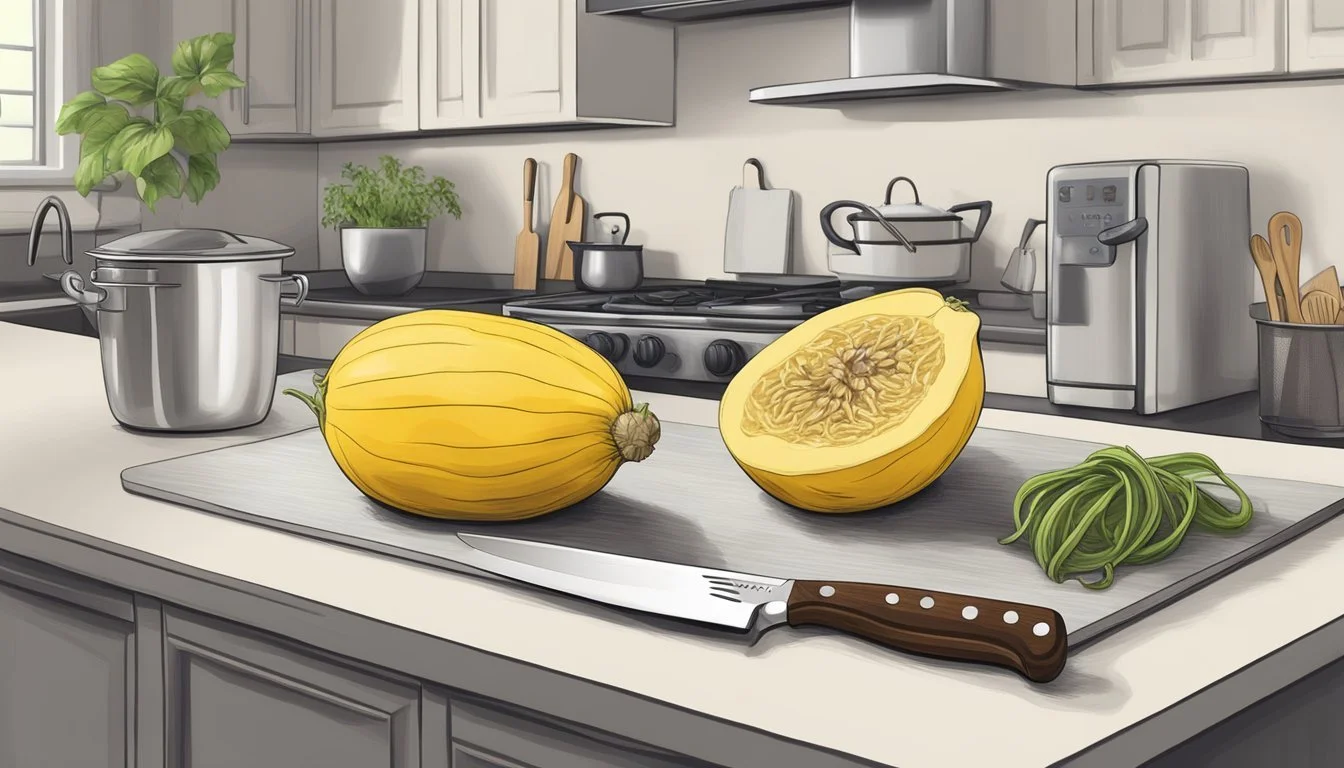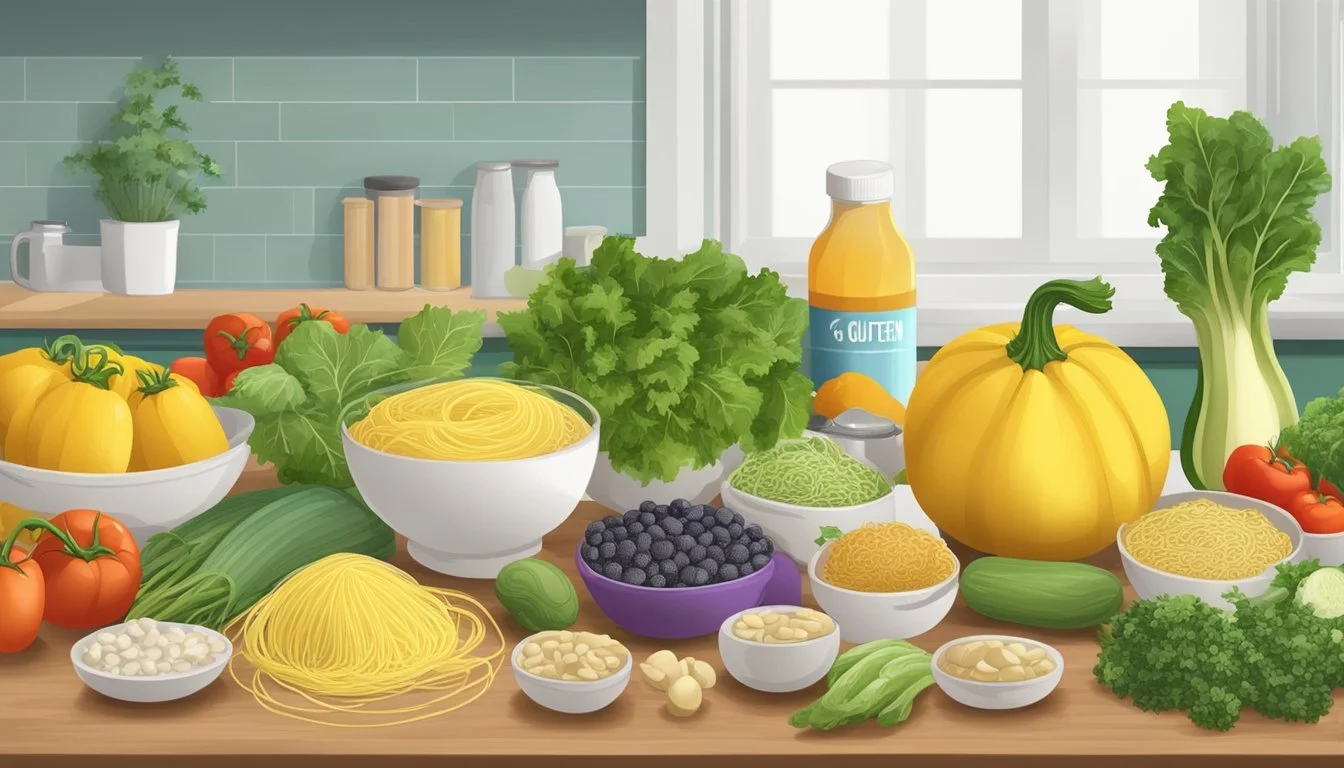How Long Does Gluten-Free Spaghetti Squash Last?
Storage Tips and Shelf Life
Spaghetti squash is a versatile and nutritious gluten-free alternative to traditional pasta that many people enjoy. Uncooked spaghetti squash can last for up to two months if stored in a cool, dry place between 55 to 60 degrees Fahrenheit. Suitable storage areas include a pantry, basement, or root cellar, ensuring the environment is dry and rodent-free to prevent spoilage.
After cooking, spaghetti squash should be placed in an airtight container and kept in the refrigerator, where it remains good for 3 to 4 days. For those who slice, peel, or cut their squash, the refrigerated shelf life extends to about 5 to 7 days. Knowing these storage guidelines helps maintain the freshness and flavor of your gluten-free spaghetti squash.
Understanding Spaghetti Squash
Spaghetti squash, a type of winter squash, is loved for its unique texture and nutritional benefits. This section explores its main characteristics, health benefits, and comparisons with other winter squashes.
Characteristics of Spaghetti Squash
Spaghetti squash, known scientifically as Cucurbita pepo, is a versatile vegetable. When cooked, the flesh pulls apart into strands resembling spaghetti. It varies in color from ivory to yellow and orange and can weigh between 2 to 5 pounds.
The seeds inside are edible once roasted. The outer skin is hard and should be pierced before cooking to prevent bursting. Storage is straightforward: whole squash lasts about a month in a cool, dark place, while cooked or cut pieces should be refrigerated.
Health Benefits of Spaghetti Squash
Spaghetti squash offers numerous health benefits. It's low in calories and carbohydrates, making it suitable for low-carb diets and people with diabetes.
Rich in dietary fiber, it aids digestion and helps in maintaining a healthy weight. The squash is also packed with vitamins like A, B, and C, which support vision, immune function, and skin health. Additionally, it contains minerals such as potassium and magnesium, vital for heart and muscle function. As it is gluten-free, it's a safe alternative for individuals with celiac disease or gluten sensitivities.
Comparisons With Other Winter Squashes
When compared to other winter squashes like butternut and acorn squash, spaghetti squash stands out due to its unique texture. While butternut squash has a sweet, nutty flavor and smooth texture, spaghetti squash has a mild taste and stringy, noodle-like consistency.
Nutritionally, spaghetti squash is lower in calories and carbohydrates than both butternut and acorn squash, making it an excellent choice for weight management. It also contains fewer natural sugars but offers the same amount of fiber and essential nutrients, making it a healthy alternative to these denser squashes. Each variety, however, brings its own distinct flavor and nutritional profile to the table.
Selecting and Preparing Spaghetti Squash
Selecting and preparing spaghetti squash involves choosing the right squash and utilizing safe cutting and cooking methods. These steps ensure the best flavor and texture while maintaining food safety standards.
Choosing the Right Squash
When selecting spaghetti squash at the grocery store or from your garden, it's essential to inspect it carefully. Look for squash that is heavy for its size and has a firm, hard rind.
Avoid any with soft spots, blemishes, or green tinge, as these can indicate immaturity or spoilage. The color should be a uniform, deep yellow. If the squash has dry, rough patches, this is normal and does not affect the quality.
A good spaghetti squash is typically between 2-4 pounds, which ensures enough flesh for a meal without being overly large and cumbersome to handle. Proper selection from the start ensures a more enjoyable cooking and eating experience.
Safe Cutting and Cooking Methods
Cutting spaghetti squash safely is crucial due to its tough exterior. Use a sharp, sturdy knife to slice off the stem end first. Then, cut the squash lengthwise. Be cautious and use a fork to stabilize the squash if needed.
After cutting, scoop out the seeds with a spoon. For cooking, brush the cut sides with olive oil to enhance flavor. Place it cut side down on a baking sheet. Cook in a preheated oven at 400°F for about 40-50 minutes until the flesh is tender.
Adjust the temperature and cook time as needed based on the thickness of the squash. These simple but effective methods ensure safe preparation and optimal texture.
Optimal Storage Techniques
Proper storage techniques can extend the shelf life of gluten-free spaghetti squash, whether it's for short-term use or long-term preservation. Below, you'll find practical guidelines for maintaining its freshness.
Short-Term Storage Tips
Storing cut or cooked spaghetti squash correctly can help retain its quality.
Refrigeration is key here; for cut squash, wrap the exposed side in plastic wrap to prevent drying out. Place it in an airtight container for best results. Typically, it lasts up to 14 days in the refrigerator.
Use airtight containers to store cooked spaghetti squash. This minimizes moisture loss and prevents contamination. Labeling the container with the storage date can help track freshness, ensuring timely consumption.
For whole spaghetti squash, keep it at room temperature in a cool, dark place like a pantry. Aim for temperatures between 50°F and 60°F to avoid spoilage, and avoid temperatures above 70°F as they accelerate degradation.
Freezing and Long-Term Storage
For extended storage, freezing is an effective method.
Ensure the spaghetti squash is cooked before freezing. Once cooked, let it cool to room temperature. Portioning into serving sizes before freezing can make thawing more efficient.
Use the following steps for best results:
Pack the cooled squash into airtight containers or heavy-duty freezer bags, leaving some space for expansion.
Squeeze out any excess air from the bags to prevent freezer burn.
Label each package with the date, ensuring you use the oldest ones first.
Frozen spaghetti squash retains quality for up to 8 months. When ready to use, thaw it in the refrigerator overnight or reheat directly from frozen.
These steps ensure that the squash remains a tasty, gluten-free option regardless of storage length.
Culinary Uses for Spaghetti Squash
Spaghetti squash is a versatile ingredient that can be used in many culinary delights due to its unique texture and mild flavor. It is particularly valued as a healthy and gluten-free alternative to traditional pasta.
Spaghetti Squash as a Pasta Substitute
Spaghetti squash is an excellent pasta substitute, especially for those who follow a gluten-free or low-carb diet. When cooked, its flesh pulls apart into spaghetti-like strands.
These strands can replace traditional spaghetti in many classic dishes. It holds up well under sauces and is perfect for keto, vegetarian, and vegan diets.
Spaghetti squash is not only healthy but also a low-calorie option, making it ideal for those watching their diet without sacrificing taste.
Complementary Sauces and Flavors
Spaghetti squash pairs wonderfully with a variety of sauces and flavors. Marinara sauce and alfredo sauce are popular choices. Marinara offers a robust, tomato-based taste, while alfredo provides a creamy, indulgent flavor. Garlic, fresh basil, and parmesan help enhance the overall taste.
Pesto is another great option, bringing a fresh and herby flair to the dish. For added complexity, consider caramelized onions, mushrooms, or a splash of balsamic vinegar.
The squash’s mild flavor allows these sauces and herbs to shine, creating a balanced and flavorful meal.
Recipe Ideas and Pairings
There are countless ways to incorporate spaghetti squash into recipes. Try Spaghetti Squash with Marinara and Mozzarella for a comforting dish. Or, Spaghetti Squash Alfredo with spinach and chicken offers a hearty, protein-rich meal.
For something lighter, Spaghetti Squash Pesto with cherry tomatoes and zucchini is delightful. Vegetarians and vegans might enjoy Spaghetti Squash with Lentils, featuring a rich blend of spices and vegetables.
Paired with fresh herbs like basil and rosemary, and additional vegetables like corn and spinach, spaghetti squash can easily be adapted to suit various palates and dietary needs.
Recognizing and Addressing Spoilage
Properly identifying and handling spoilage in gluten-free spaghetti squash can ensure its safe consumption and maximize its shelf life. Awareness of visual and textural cues, along with appropriate storage techniques, is essential.
Signs of a Bad Spaghetti Squash
There are key indicators that a spaghetti squash has gone bad. A noticeable change in texture, such as soft spots or the presence of mushy areas, often signifies spoilage.
Color changes are another important sign. Spoiled squash might appear pale or develop green spots, both of which indicate it is no longer good for consumption.
A bad odor is also a clear signal of spoilage. Fresh spaghetti squash has a neutral smell, so any strong, unpleasant scent suggests it has gone bad.
Preventive Measures and Handling
Proper storage is crucial in preventing spoilage of gluten-free spaghetti squash. Refrigeration can extend its life, particularly during warmer months when room temperature is not ideal.
Whole, uncut squash should be stored in a cool, dry place like a pantry or cellar. This helps maintain its quality for up to three months.
After cutting, gluten-free spaghetti squash should be kept in an airtight container or wrapped tightly in plastic wrap and refrigerated. This method helps keep it fresh for 5 to 7 days.
Monitoring storage conditions and regularly inspecting the squash will help catch early signs of spoilage, ensuring safe and enjoyable meals. Proper handling and storage techniques are essential to maintain the quality and safety of gluten-free spaghetti squash.
Nutritional and Dietary Considerations
Spaghetti squash is not only gluten-free but also provides various nutritional benefits, making it a healthy alternative in many diets. This section addresses its calorie and carbohydrate content, allergen information for those with celiac disease, and the essential vitamins and minerals it provides.
Counting Calories and Carbs
Spaghetti squash is a low-calorie food, with roughly 30 calories per half-cup serving (112 grams). This makes it an excellent choice for those looking to reduce caloric intake. Additionally, it's low-carb, containing only 7 grams of carbohydrates per half-cup serving.
For individuals on low-carb diets, spaghetti squash serves as a healthy substitute for traditional pasta, which is higher in both calories and carbohydrates. Its natural sweetness and mild flavor allow it to pair well with various sauces and toppings while maintaining a low-calorie profile.
Allergen Information and Gluten-Free Dieting
Spaghetti squash is inherently gluten-free, which is essential for individuals with celiac disease or gluten sensitivities. The lack of gluten makes it safe for those who need to avoid gluten due to medical conditions.
For those on a gluten-free diet, spaghetti squash offers a versatile and nutritious option. It's free from common allergens found in many grain-based products, making it a reliable choice across various dietary restrictions. Gluten-free labeling ensures that even those highly sensitive to gluten can enjoy this nutritious vegetable without concern.
Vitamins, Minerals, and Other Nutrients
Spaghetti squash is rich in several important nutrients. It provides a good source of dietary fiber, which aids digestion. Additionally, it contains potassium, which is vital for maintaining healthy blood pressure levels, and vitamin C, which supports the immune system.
The squash also includes vitamin A, essential for eye health, and B vitamins, which are crucial for energy metabolism. Manganese and calcium are present as well, benefiting bone health. These nutrients contribute to the overall health benefits of spaghetti squash, making it a well-rounded addition to a balanced diet.








